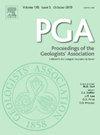Do REEs in mudstones record bottom-water redox?: The Pliensbachian–Toarcian record (Lower Jurassic) and T-OAE in the Cleveland Basin, England
IF 1.2
4区 地球科学
Q2 Earth and Planetary Sciences
引用次数: 0
Abstract
The Pliensbachian–Toarcian of the Cleveland Basin provides a global reference for the interval incorporating the Toarcian Oceanic Anoxic Event (T-OAE ~ 183 Ma). Palaeoredox proxies show a progressive shift from oxic bottom waters in the late Pliensbachian through dysoxic–anoxic conditions in the earliest Toarcian to euxinia during the T-OAE. Anoxia–dysoxia persisted into the middle Toarcian. Laminated black shales with TOC contents > 2.5 % characterise the anoxic–euxinic intervals. The rare-earth element (REE) geochemistry of the succession sampled in the Dove's Nest core is described and compared to data from nearby Yorkshire coastal outcrops. Interpretation is based on a review of REE behaviour in modern marine water columns, pore waters and sediments. Mud(stone) REE patterns are insensitive to bottom-water redox conditions. The REEs are principally located in the siliciclastic clay fraction of modern marine muds and ancient mudstones. Bulk mud(stone)s generally exhibit relatively flat REE patterns when normalised to average shale. Cerium anomalies are largely absent. Stratigraphical trends in the Yorkshire succession are related principally to sediment grain size. Authigenic and biogenic phosphates, principally carbonate fluorapatite, when present, dominate the whole-rock REE inventory leading to convex-upward patterns and large positive middle REE (MREE/MREE*) anomalies. These occur sporadically throughout the oxic–euxinic intervals, showing no correlation to bottom-water redox. The REE geochemistry of marine mudstones presents a combination of primary mineralogical and grain-size controls related to sediment provenance combined with the impact of authigenic mineral formation. Bulk mudstone REE patterns do not provide a viable bottom-water redox proxy.
泥岩中稀土元素是否记录了底水氧化还原?克利夫兰盆地的Pliensbachian-Toarcian记录(下侏罗统)和T-OAE
克利夫兰盆地的Pliensbachian-Toarcian为Toarcian海洋缺氧事件(T-OAE ~ 183 Ma)的发生提供了全球参考。古氧化还原指标显示,在T-OAE时期,从普林恩巴氏世晚期的缺氧底水,到最早的托瓦良期的缺氧-缺氧条件,是一个渐进的转变。缺氧-呼吸困难一直持续到托瓦西亚中期。黑色层压页岩TOC含量>;2.5 %为缺氧-缺氧区间。描述了鸽子巢岩心中演替序列的稀土元素地球化学特征,并与附近约克郡海岸露头的数据进行了比较。解释是基于对现代海洋水柱、孔隙水和沉积物中稀土元素行为的回顾。泥(石)稀土元素模式对底水氧化还原条件不敏感。稀土元素主要分布于现代海相泥和古泥岩的硅塑性粘土组分中。当正态化到平均页岩水平时,大块泥(石)通常表现出相对平坦的REE模式。铈异常基本不存在。约克郡演替的地层趋势主要与沉积物粒度有关。自生和生物成因的磷酸盐,主要是碳酸盐氟磷灰石,当存在时,主导整个岩石的REE库存,导致凸向上模式和大的正中REE (MREE/MREE*)异常。这些现象在氧-氧区间零星发生,与底水氧化还原无关。海相泥岩的稀土元素地球化学特征表现为原生矿物学与沉积物物源相关的粒度控制以及自生矿物形成的影响相结合。大块泥岩稀土元素模式不能提供一个可行的底水氧化还原指标。
本文章由计算机程序翻译,如有差异,请以英文原文为准。
求助全文
约1分钟内获得全文
求助全文
来源期刊
CiteScore
2.70
自引率
8.30%
发文量
54
审稿时长
6-12 weeks
期刊介绍:
The Proceedings of the Geologists'' Association is an international geoscience journal that was founded in 1859 and publishes research and review papers on all aspects of Earth Science. In particular, papers will focus on the geology of northwestern Europe and the Mediterranean, including both the onshore and offshore record. Following a long tradition, the PGA will focus on: i) a range of article types (see below) on topics of wide relevance to Earth Sciences ii) papers on aspects of Earth Science that have societal relevance including geoconservation and Earth management, iii) papers on palaeoenvironments and palaeontology of the Mesozoic and Cenozoic, iv) papers on aspects of Quaternary geology and climate change, and v) papers on the history of geology with particular reference to individuals that have shaped the subject. These topics will also steer the content of the themes of the Special Issues that are published in the PGA.

 求助内容:
求助内容: 应助结果提醒方式:
应助结果提醒方式:


